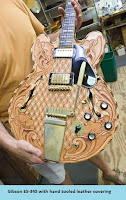So from the late 1950’s on there have been guitarists that have covered their instruments in leather. It was all about stage presence and show.
Elvis had several guitars wrapped in leather. His first was a 1955 Martin D-28 that he purchased at O.K. Houck Piano Company in Memphis Tennessee in April of 1956.
The leather tooled covering was made by Marcus Van Story, who worked for the O.K. Houck Piano Company as a repairman.
Presley got the idea because he admired a similar guitar cover used by Hank Snow and decided he needed one. I do not know where Hank Snow got his, but it was elaborate and had his name engraved across its top.
 |
| Ernest Tubb's Martin 00-18 |
Other Country artists had their names inlaid in mother-of-pearl on their guitars fret boards. However the leather guitar cover was a real eye-catcher, despite the fact that it probably muffled the sound.
In October of 1956, Presley purchased a brand new Gibson J-200 from the same music store.
This was covered with a tooled leather cover made by Charles Underwood in 1957. It was first seen on the Ed Sullivan Show that same year.
 |
| Rick Turner with Holly's guitar |
Years later Gary Busey, who starred in The Buddy Holly Story purchased Buddy’s Gibson J-45, with the leather cover for $270,000. Rick Turner has also made beautiful replicas of this same leather guitar cover.
 |
| Conway Twitty |
Twitty already owned and played electric guitar which was a 1957 Gretsch 6130 Roundup solid body electric guitar. This guitar came from the factory with leather binding on the instruments sides that were embossed with medallions that looked like sheriff badges.
But Twitty decided to have a hand-tooled leather guitar cover custom made for his Gretsch guitar. His name is embossed in cursive script on the upper bouts.
On the back of the guitar is a characture of his wife, Maxine, who he called “Mick. She is embossed on the covers back and is shown wearing chaps and a cowboy hat.
Another popular artists of those day was Ricky Nelson. If you grew up in the 1950’s, you probably watched the television show, The Adventures of Ozzie and Harriet. Ricks father, Ozzie led an orchestra in the 1940’s and was the bands singer. His mother, Harriet was the bands female vocalist.
So it was not surprising that Ricky developed a beautiful singing voice. I discover that while he was at a recording session he heard a session guitarist that was about his same age named James Burton. Burton was recording in another studio.
Rick liked his style and invited him to be not just a regular in his band, but also appear on the TV show.
At the time Rick owned a Rickenbacker acoustic guitar that was about the same size as a Gibson jumbo guitar.
He had a beautiful leather guitar cover for this guitar and of course it had his name engraved in the leather.
As Nelson became more famous, he purchased a Gibson J-200 and had a leather cover made for it.
Later in his career Ricky purchased a Martin guitar and he had a custom leather cover with his name made for this instrument. Judging be the rosewood neck, it is a Martin D-18.
He also received a red, white and blue guitar as a gift from Buck Owens.
Buck thoughtfully included a leather cover.
The leather cover fad seemed to have fallen out of fashion until a clean-cut Waylon Jennings, took his Fender Broadcaster to a leather-smith and had a black and white hand-tooled leather cover made for the instrument. This guitar became Jennings trademark.
Shortly afterward he purchased two Fender Telecasters and gave them the same treatment. It is said that Jennings owned at least 7 Fender Telecasters with leather coverings, although one was actually an Esquire.
Jennings gave away the Broadcaster to a friend. Seven years after his death, this guitar showed up in an auction in 2009 at Christies and was purchased for $98,500.
Fender Musical Instruments made a Waylon Jennings Telecaster Tribute guitar during his lifetime. They had his stylized “W” logo at the 12th fret on their maple necks. Jennings owned several of these guitars.
His son, Shooter Jennings, plays his fathers Telecaster with his own band.
During the late 1980’s Chris Isaak’s became popular. He was a singer and songwriter, but before this he earned a living as a male fashion model.
Isaak's song Suspicion of Love appeared in the film, Married to the Mob. In 1990 his song Wicked Game was featured in the David Lynch film, Wild at Heart. A VH1 music video featured Isaak and supermodel Helen Christensen in a sensual beach encounter.
In 2001 Isaak starred in his own television variety show. During his stage act, Isaak wore flashy suit jackets with medallions on the lapels.
In later years he acquired a Gibson Chet Atkins Country Gentleman and enclosed that instrument in a leather cover.
There are a number of artisans throughout the United States that will provide leather guitar covers.
Guitars N' Things in Nashville, Tennessee offers reasonable prices on hand-tooled leather covers.
Mosby Guitars and Custom Inlay is located in Myrtle Beach, South Carolina and does custom leather hand-tooling work.
For those who are adventurous, I've found this site with step-by step instructions.
Here are a few examples of folks that have done their own work with great results.
This is a leather guitar cover made for a Martin Eric Clapton model.
And this beautiful example if a Gibson ES-345 covered in leather.
Click on the links for more information.
©UniqueGuitar Publications (text only)
Ozzie and Harriet Show - Ricky Nelson & James Burton
Waylon Jennings Telecaster Reissue
Elvis on The Ed Sullivan Show 1956











































